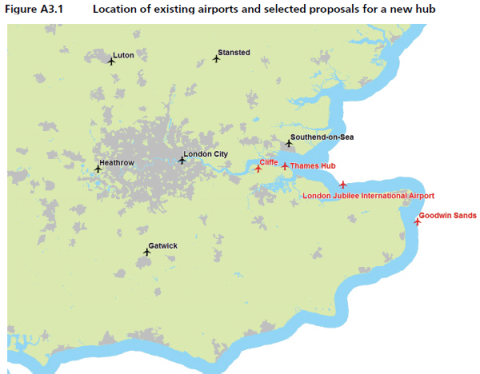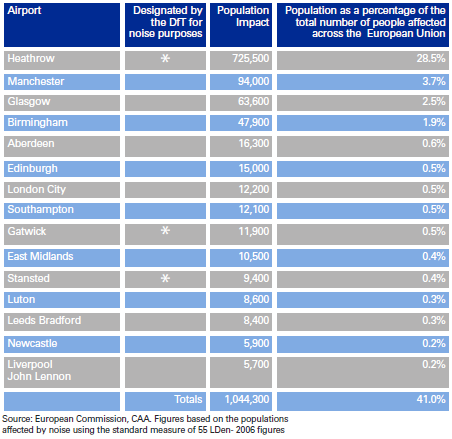Heathrow expansion: what are the facts behind the third runway debate?
"The government should reject the "Boris Island" Thames Estuary airport plan and expand Heathrow instead, a report by MPs on the House of Commons Transport Committee has said."
BBC News, 10 May 2013
The House of Commons Transport Select Committee placed itself on a collision course with London Mayor Boris Johnson today as it released it's first report of the 2013-14 session into the Government's aviation strategy.
The Committee rejected calls fronted by the Mayor for a new 'hub airport' in the Thames Estuary, along with other options east of London. Instead, the Committee proposed, Heathrow airport should be expanded with a third runway, and possibly even a fourth:
"We conclude that a third runway at Heathrow is necessary, but also suggest that a four-runway proposal may have merit, especially if expanding to locate two new runways westwards from the current site could curb the noise experienced by people affected under the flight path. "
However, it's precisely this noise factor that has featured in arguments against the third runway. Last week another transport committee - that of the London Assembly - called for no expansion of Heathrow airport, citing several times their concerns about the noise impact on the people of Heathrow, as well as the consequences for Heathrow jobs if another airport were to absorb demand.
The debate is set to reach a head in December this year when a new expert panel on the Airports Commission, led by Sir Howard Davies, will assess the UK's long term aviation needs.
This is clearly a debate that's already built up a head of steam and looks set to continue some time into the future. So what are the facts colouring the arguments?
Capacity and demand
One of the main reasons it's claimed to be necessary to expand the UK's aviation capacity is that the country's main 'hub' airport - Heathrow - is operating at 'full capacity', and demand is set to continue rising in the future, putting ever more strain on our aviation infrastructure.
So what does all this mean?

To start with, it's worth putting UK airports' current use in context. Heathrow is, of course, the most used airport in the country. In the year to February 2013, 70 million passengers used terminals at the airport, almost a third of the UK's passengers at all airports.
Capacity itself is actually quite a difficult concept to measure. York Aviation, in their report to the London Assembly committee, outline no fewer than five different ways that capacity is measured - in terms of runways, aprons (where planes 'park'), the passenger terminal, surface access and environmental limits specific to the airport.
However the most commonly-used measure is to focus on runway capacity, that is, the number of aircraft movements that can be handled in a given time period. Less busy airports will have more spare 'slots' available for take-offs or landings, which can be useful if one service is delayed. As such, the higher capacity is used up, the more prone to congestion the airport will tend to be.

The Department for Transport (DfT), provide 2010 estimates for airport runway capacity used, shown on the right.
What's more, demand is forecast to increase. The DfT also provide estimates (revised thanks to the recession) of how passenger demand will change in the coming years.
They show that in 2010 about 211 million people used UK airports. By 2030, if no runways or terminals are built in the UK, this is set to increase to 315 million. What's more, if demand was 'unconstrained' by capacity, it would rise to 320 million - hence creating a 5 million 'capacity gap'.
The proposals
Of course expanding Heathrow isn't the only way to do this. The Transport Select Committee highlights and considers a number of possibilites for new airports:

The Committee's view was that a thrid runway at Heathrow was necessary "to meet existing and future demand that can be reasonably predicted". The Committee's Chair, Louise Ellman, made clear on the BBC's Today Programme that other options such as the Thames Hub would be costly not only in initial construction but to Heathrow itself.
The 'hub' problem
Part of the difficulty pointed out by the Commons Committee was the fact that merely expanding some of the UK's other airports doesn't do anything to combat the capacity problem at Heathrow - the UK's main 'hub' airport.
Hub airports are deemed important as they have large quantities of passengers that don't actually start or finish their journeys at the airport, but actually transfer to other flights as part of a longer journey.
For instance, the London Assembly Transport Committee reports that:
"It is not clear how many of Heathrow's passengers are transferring with estimates ranging from 22 to 36 per cent"
In other words, from a fifth to over a third of Heathrow passengers are actually coming from and going to a separate destination.
However, looking at the actual evidence from York Aviation, it's actually quite clear. Data from the Civil Aviation Authority (CAA) shows that 22% of all Heathrow passengers were transferring between flights. The 36% comes about if you count each transferring passenger twice. This isn't unreasonable as a measure, as Heathrow's own surveys do this to acount for everyone arriving and departing from the airport, and to model each individual flight's demand.
As the table below from York Aviation shows, Heathrow is way out in front of other London airports on this measure:

Noise
All these figures borne in mind, what should we make of the objections from Boris Johnson and campaigners about noise levels? Full Fact has already looked into the number of people affected by noise at Heathrow when the Mayor claimed last year that a quarter of Europe's sufferers lived near the west London hub:

As we can see, the Mayor's claim does seem to be supported by the figures. Whether or not the Transport Committee's proposals to site the new runways further west would mitigate remains to be seen.